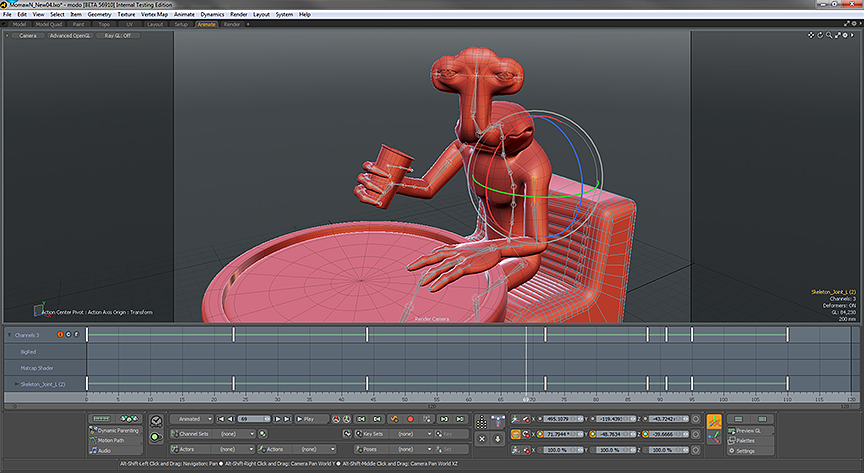
The 'Animation' Layout interface is a workspace specifically refined for the task of animation. The workspace is set apart from others by its larger 3D viewport. This maximizes the space allowing users to concentrate on the task of animating and bringing their characters to life. Another notable difference is the main toolbox location across the bottom of the screen with a focus on setting and refining keyframes in the most efficient manner. Directly below the 3D viewport itself is the Track view (aka Dope Sheet) covered on its own documentation page. Users can access it by LMB+clicking and dragging the top of the frame for the Timeline. The toolbox below the timeline contains the tools necessary to shuttle the timeline, control view settings, add, edit and remove keyframes and refine animation timing. Some tools are unique to the Animation layout, documentation coverage will work left to right describing each one-

The first five buttons allow quick access to the 'Spacing Chart' and 'Inbetween' Tools, as well as the 'Dynamic Parent', 'Motion Path' and 'Audio' control popups.
Spacing Chart
The Spacing Chart is designed to aid animators in a workflow popularized by traditional hand-drawn animation, concentrating on the poses of the character, treating a keyframe position like a single drawing in an animated sequence. Basically it allows animators to define specific key poses for a character before working out the timing. Once the poses are set, then the timing can be modified independently. Use of the tool is covered on its own documentation page. Please reference that page for more information.
The 'Inbetween Tool' is very useful for quickly creating poses between another pair of poses or for adjusting existing poses. It can be used for building overlap or follow through, or to create moving holds etc., anything where a pose, or parts of a pose, need to be biased towards their preceding or following poses (keyframes). The requirements for using the tool are that the target item needs to be part of an 'Actor', and that the items being edited must have at least one key on it's transform channels before and after the time at which the tool is being applied. All Action/Channel interpolation types are supported, for example an inbetween will still be created when using stepped curves.
The tool is activated by clicking on the button at the right of the toolbar area, when active the word 'Inbetween' will be displayed in the viewport near the axis widget as an indicator of its active state. To create a new pose simply set the timeline's current time to where the pose keyframe is desired, activate the tool and RMB+click and drag directly in the 3D view. Dragging will move the target item in time, as the tool adjust the Inbetween pose. Releasing the mouse button fixes the pose to the now current location. Dragging left adjusts the new pose towards the previous pose, right adjusts towards the next pose. If there are no items directly selected, but there is a current 'Actor' and 'Action' active, then all items in the Actor that have surrounding keys at the current time will be edited.
To edit an existing pose select the target item, or hierarchy of items to edit, and position the timeline indicator at the position to be edited. Next RMB+click and drag in the 3D viewport as above. The tool will take the existing transform of the items into account and bias the pose from there. If there are no selected items then the tool will work with the current Actor as described above.
Parenting is the act of creating a hierarchy and relating the motion of one object to that of another. Standard parenting hierarchies are fixed, therefore not animateable, but sometimes one needs to change what an item is parented to over time. That is where Dynamic Parenting comes in, allowing users to keyframe what an item is parented to and when. For example, on an assembly line a product would move on a conveyor belt that is then picked up by a robotic arm and then placed into a package and moved. The item would first need to be parented first to the conveyor belt, then to the robotic hand and finally the product box. This allows the user to only have to animate the conveyor, robot arm and box, and the dynamically parented object will simply go along for the ride.
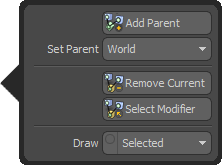 The Dynamic Parent toolbox will open in a popup with the associated controls when 'Dynamic Parenting' button is LMB+clicked. Prior to opening the popup, users should select the target item to be parented (in 'Items' mode). Once selected, users can click the 'Add Parent' button to initialize the Dynamic Parenting controls for the target (Should be assigned while the timeline is at frame 0). This adds the 'Dynamic Parent' channel modifier and provides some in-viewport controls to make it simple to define the Parent/Child relationships.
The Dynamic Parent toolbox will open in a popup with the associated controls when 'Dynamic Parenting' button is LMB+clicked. Prior to opening the popup, users should select the target item to be parented (in 'Items' mode). Once selected, users can click the 'Add Parent' button to initialize the Dynamic Parenting controls for the target (Should be assigned while the timeline is at frame 0). This adds the 'Dynamic Parent' channel modifier and provides some in-viewport controls to make it simple to define the Parent/Child relationships.
Using the popup control, users need to only shuttle the timeline to the appropriate position and then use the 'Set Parent' option to set the target parent item within the scene defining the Parent relationship. Once a Parent is assigned, that parent will remain associated moving forward in time until the next assignment is applied. The 'World' option is like unparenting the item in-place, it will remain in the position it is in when the option is selected.
Users can set as many different parent items as required, but only a single parent can be assigned per key. The 'Remove Current' button when pressed will remove the current parent from the target, leaving the other assignments in place, while the 'Select Modifier' button selects the actual Dynamic Parent modifier item in the 'Items' list so users can modify its attribute in the 'Properties' panel. The 'Draw' control defines the drawing of the control handle in the 3D viewport- 'Off' the handle will never be drawn, 'On' the handle will always be drawn, and 'Selected' will draw the handle only when the target item is selected.
Dynamic Parenting can also be assigned dynamically directly in the 3D viewport using the control handle. With the target item selected, and the Dynamic parenting option enabled, users need only to drag the control whip (purple dot) to the target parent item to link them. RMB+clicking on the control will unparent the items. This video demonstrates that process-
Motion Paths are a useful visual aid for seeing how an item will move over time within a scene. MODO's Motion Path feature goes a step further and allows users to directly edit the curves like three-dimensional beziers in the GL viewport, additionally allowing users to adjust the positional easing of the keyframes with each frame step visually identified as a dot along the path.
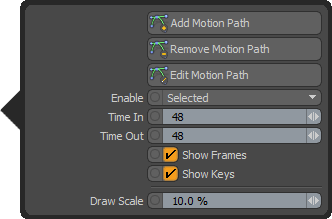 Users can view any animation path by first selecting the target item. Note that some position keyframes will need to be assigned to the target prior to adding the path (no motion on the item means there will be no path to view). Once selected, LMB+clicking the 'Motion Path' button opens the popup and users can click on the 'Add Motion Path' button, drawing the path. The green section of the path represents the length of time behind the current location and the purple path represents time in front of the item.
Users can view any animation path by first selecting the target item. Note that some position keyframes will need to be assigned to the target prior to adding the path (no motion on the item means there will be no path to view). Once selected, LMB+clicking the 'Motion Path' button opens the popup and users can click on the 'Add Motion Path' button, drawing the path. The green section of the path represents the length of time behind the current location and the purple path represents time in front of the item.
To modify the path directly in the 3D viewport, users will need to enable the 'Edit Motion Path' option by pressing the button in the popup. This will draw the path within the viewport as a ribbon, representative of the Z-axis rotation of the item along its length. At each keyframe location small cyan cubes will draw that users can LMB+click and drag to reposition. Tangent handles will draw on a selected key. Users can click and drag the tangent handles to adjust the curvature of the incoming and outgoing curve.
How the curve is edited is dependent on which channels are keyed at the keyframe location. All three (X,Y,Z) channels must be keyed at any location for free curvature editing, otherwise it will be locked to the particular axis that was keyed. RMB+clicking and dragging the handles will adjust the easing in/out of the key without adjusting the paths shape (Ctrl+LMB+click has the same effect). Clicking the 'Edit Motion Path' button again will disable editing of the path. Users can define the display of the path with the 'Enable' option- 'Off' the path will never be drawn, 'On' the path will always be drawn, and 'Selected' will draw the path only when the target item is selected.
The Time In/Out' options control the number of keyframes before and after the current location that are displayed, essentially controlling the length of the path around the current time. The 'Show Frames/Keys' toggles control the visibility of the small frame step tick marks on the path and the cyan cube keyframes respectively. The 'Draw Scale' option controls the thickness of the ribbon as it relates to the path. A value of '0%' disabled the ribbon aspect of the path drawing. The path display for an item is disabled by clicking the 'Remove Motion Path' option in the popup when the target item is selected.
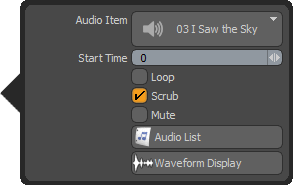 Audio is often an important part of the animation workflow for syncing actions to sound cues or more importantly lip sync with a character. MODO can load sound files and play them back with the timeline. This is done by using the controls found in the 'Audio' popup. opened with a LMB+click. Once loaded the audio waveform is represented visually inside the timeline. Clicking the 'Audio Item' opens the 'Audio' viewport popup allowing users to load and select a variety of audio file formats. Clicking on a loaded file will select it, assigning it as the current audio file to the timeline. Once the file is loaded as such, any subsequent playback of the timeline will play the audio (or course proper playback hardware is required).
Audio is often an important part of the animation workflow for syncing actions to sound cues or more importantly lip sync with a character. MODO can load sound files and play them back with the timeline. This is done by using the controls found in the 'Audio' popup. opened with a LMB+click. Once loaded the audio waveform is represented visually inside the timeline. Clicking the 'Audio Item' opens the 'Audio' viewport popup allowing users to load and select a variety of audio file formats. Clicking on a loaded file will select it, assigning it as the current audio file to the timeline. Once the file is loaded as such, any subsequent playback of the timeline will play the audio (or course proper playback hardware is required).
The 'Start Time' setting controls at which frame the audio file will start to play. The 'Loop' toggle will play shorter sound files consecutively, repeating the file when the end is reached. The 'Scrub' option controls playback of audio when the timeline is manually shuttled. 'Mute' will temporarily disable the audio playback. The 'Audio List' button toggles the display of the 'Audio List' popup, where users can select audio items and further edit their associated attributes in the Properties panel. The 'Waveform Display' toggle will enable or disable the display of the audio files waveform in the timeline itself. Additional details regarding the usage of of audio in MODO is covered on the 'Using Audio Overview' page of the documentation.
The Time tool allows users to shuttle the timeline indirectly while in the 3D viewport. This is helpful for increasing efficiency when adjusting items in the viewport, eliminating the need to go directly to the timeline and manually scrub back and forth. LMB+clicking the 'Time Tool icon will activate the function adding its controls as an overlay to the 3D viewport. The largest number in the overlay displays the current timeline location in the chosen format, and the smaller number in the display shows the current time as, well time.
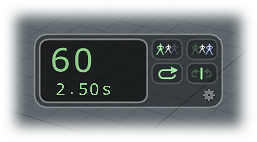
Outside of the display itself, the time tool allows users to use the middle and right mouse buttons to control the timeline. When it is active, RMB+clicking in the 3D viewport allows users to drag the mouse to scrub the timeline position, MMB+clicking in the viewport will invoke real-time playback of the timeline around the current time. The overlay has a few buttons as well that provide additional functionality for improving workflow-
![]() LMB+click temporarily jumps to the previous keyframe, RMB+click steps the timeline to the previous keyframe.
LMB+click temporarily jumps to the previous keyframe, RMB+click steps the timeline to the previous keyframe.
![]() LMB+click temporarily jumps to the next keyframe, RMB+click steps the timeline to the next keyframe.
LMB+click temporarily jumps to the next keyframe, RMB+click steps the timeline to the next keyframe.
![]() Determines the MMB playback mode, toggles between 'Loop' or 'Ping-Pong'.
Determines the MMB playback mode, toggles between 'Loop' or 'Ping-Pong'.
![]() Scrub-mode control when enabled returns the timeline position to the current time when the mouse button controls are released.
Scrub-mode control when enabled returns the timeline position to the current time when the mouse button controls are released.

Clicking the gear icon opens a dialog that allows users to define the 'Auto Play Range', the number of steps around the current time that is played when pressing the MMB. There is also an option toggle to use the mouse wheel to step through keyframes when enabled.
The 'Use Viewport Regions' option places easy access viewport overlay buttons for the keyframe jump controls. The button regions are invisible until the user hovers the cursor over the designated 'Viewport Regions Locations' (on the 'Sides' or the 'Top Corners'). They will appear as transparent gray boxes when visible, then users can LMB+click them to jump to the previous or next keyframes temporarily, or RMB+click to step the timeline to the next or previous keyframe (direction depends on the button pressed, left side button goes back, right side goes forward).
Note that the time tool does not operate like a regular tool as other tools can be activated and applied while it is active. Also the 'Time Tool' uses the middle and right mouse buttons, and therefore will override any additional functionality they provide for specific tools. Disabling the 'Time Tool' function can only be done by pressing the Time Tool button again.
The Keyframe tool adds a control widget to the 3D viewport allowing users to visualize and modify keyframes directly in the animation view. LMB+clicking the keyframe tool button enables the widget so when any item is selected that has keyframes associated with it, the widget will draw, connecting to to the items 'Center' location. The color of the widget signifies its current state. Red for a keyframe, green when animated, but no keyframe and blue when there are a mix of keyframes on the item.
Clicking the small + sign will open the keyframe popup showing the keyframe states for any/all animated transforms of a given item. Users can LMB+click the dots that represent the X, Y & Z channels for each transform, to toggle the keyframe state for each. Clicking the transform icon itself automatically keys all three channels. LMB+clicking on a green dot sets a key for that channel, changing it to red. LMB+clicking on a red dot removes the key and clicking when the widget dot is blue will set a key for all animated channels.
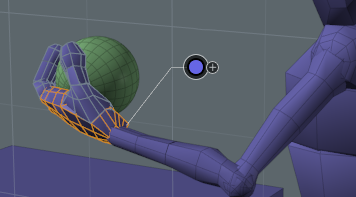
| 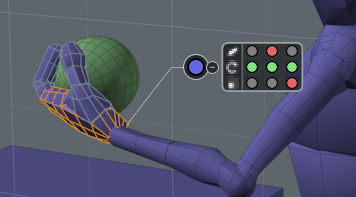
|
Note that the tool only works for items that currently have keyframed transform channels, the widget will not draw when non-animated items are selected.
Animation Timeline Controls
![]()
The timeline controls provide the functions for shuttling the timeline. LMB+clicking on the button will activate the function. Some buttons also have alternate functions that can be accessed by RMB+clicking on the button. Keyboard shortcuts for timeline transport are found in the timeline page of the documentation.
| This popup controls the Auto Keyframe settings covered on the timeline page of the documentation. | ||
| Moves timeline to the first frame of the Current Start position. | ||
| Moves timeline backwards one frame. | ||
| Input field displays the current timeline position and allows users to manually define the current frame value. | ||
| Moves timeline forward one frame. | ||
| Moves timeline to last frame of Current End position. | ||
| This is the Play button and will play the timeline forward, RMB to access the 'Reverse' play button. | ||
| (Play Keys) Plays only the keyframes for the current Actor (also supports the 'Range' Time Markers) | ||
| Extract frame option removes a frame, moving all following keyframes one frame backwards.* | ||
| Insert frame option adds a frame, moving all following keyframes one frame forward.* | ||
| Moves timeline to first keyframe position for the selected item(s). | ||
| Moves timeline to previous keyframe position. | ||
| Assigns a keyframes to all currently selected channels. | ||
| Assigns a keyframe to all animated channels belonging to the currently selected items. | ||
| Assigns keyframes to all animated channels belonging to the items in the 'Actor' and also any channel members. | ||
| Assigns keyframes to all animated channels belonging to the items in the 'Group'. | ||
| Moves timeline to next keyframe position. | ||
| Moves timeline to last keyframe position. | ||
| * These contols also work with 'Actions' when applied while one is active (and no items or channels are selected). | ||
![]()
Channel Sets
Channel Sets allow a collection of channels from the same or different items to be displayed in the 3D views with an interface similar to the 'Channel Haul' tool. There are two main differences, first is the interface will remains open until the user explicitly closes it, even when selecting other items in the scene. Second is the hauling controls of the 'Channel Haul' tool are replaced by keying buttons.
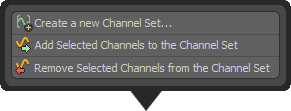
Sets are created in the 'Channel Sets' popup. By selecting a single Item in the 'Items' list (or the 3D viewport) and then selecting the target channels in the 'Properties' or 'Channels' viewport, users can LMB+click on the 'Channel Sets' button opening the popup. Selecting the 'Create new Channel Set...' option will open the 'New Channel Set' dialog where a name is defined for the set. Options for the dialog should be left at their default values with the 'Mode' set to 'From Selected Channels', automatically adding the previously selected channels to the set when it is created. Pressing OK will create the Set and and activate it, making the channel display visible in the 3D viewport.
Additional Channels can be added from other items with the 'Add Selected Channels' option while 'Remove Selected Channels' option will eliminate the target Channels from the active Set. The popup menu following the creation controls allows the user to choose the current 'Channel Set', this is the set that will display it's interface in the 3D views. Setting this to "(none)" will close the interface.
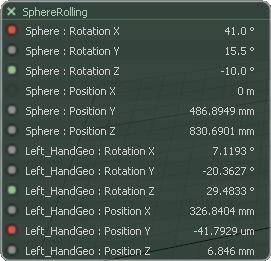
The viewport interface works much like the 'Channel Haul' tool, channel values can be changed by LMB+clicking on the channel name and dragging horizontally. Clicking on the numeric value of the channel will open an inline edit field. The interface can be moved around in the 3D views by dragging the header area that contains the name of the set and closed by clicking on the cross button on the upper left. The main difference with the 'Channel Haul' tool is that instead of hauling controls to the left of the channel name the Channel Set interface has controls for keyframing the channels. These work in the same way as the controls in the 'Properties' viewport, clicking on them will toggle the key state of the channel at the current time (or at the Key time set by middle mouse dragging in the Timeline).
'Channel Sets' are a special type of Group so they can be created and edited in the 'Groups' viewport. The current Channel Set is the one that's displayed in the 3D views and can be chosen from the popup menu in the toolbar. When a channel set is selected, the Graph Editor and the Dope Sheet will display the contents of the current Channel Set.
Directly to the right of the 'Channel Set' controls is the animated channel toggle. When no 'Channel Sets' are active, (i.e. it is set to 'none'), The animated channel toggle, when enabled, will display any channels associated to the current selection that are animated (i.e. contain keyframes) in the channel sets in-viewport window. This can be a convenient time saver allowing users to work with channels by simply adding keyframes, without needing to make specific Sets to work with.
'Key Sets' provide a convenient and quick way of adding keys to multiple channels at once. Key sets can be created in advance, for example one might create a 'Key Set' for all the animated channels in a character, it's arms, hands etc, or they can be created as you work by adding or removing channels as needed. The active 'Key Set' is chosen from the popup menu and setting keys on all the channels in the set is assigned with the keying button directly to the right of the 'Key Set' controls.
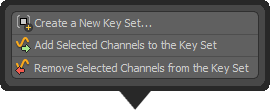
'Key Sets' are created and modified in the same manner as 'Channel Sets' by selecting an Item and the target channels and then LMB+clicking the 'Create a New Key Set...' button. This opens the 'New Key Set' dialog where the name of the set is entered. Clicking 'OK' will create the set and set it as active. When a specific key set is active, pressing the 'Key' button will define a keyframe for all items within the key set on the current frame (regardless if the items are selected or not).
The Filter option can be enabled to control visibility of certain 'Key Sets' associated to an 'Actor'. This association is created by Parenting the Group items together; assigned in the 'Groups' viewport by LMB+clicking the 'Key Set' group and dragging and dropping it onto the 'Actor' groups. When assigned as such, it will only be displayed in the popup menu when that 'Actor' is active. This is useful when working with multiple Actors that each have their own uniques Key Sets.
Action, Actors and Poses
![]()
The 'Actor', 'Action' and 'Pose' options provide users controls for simplifying the necessary steps when selecting and keyframing elements in a complex scene. 'Actors' are collections of multiple items that provide ease in selecting the associated elements and setting keyframes. 'Actions' are alternate takes of the same timeline for an entire Actor and 'Poses' are a collection of specific keyframe values that can be applied anywhere along the timeline for all or part of an 'Actor' (such as different hand positions). There are a variety of consideration when working with 'Actors', 'Actions' and 'Poses', so much so that it required its own dedicated page. Please reference the 'Actor', 'Action' and 'Pose' page of the documentation for more information.
The Hierarchy Mode options provide a workflow enhancement that allows users to set implicit selections of items based on hierarchy. For instance, this would allow users to keyframe all the fingers in a hand while only having a single finger joint actually selected. Generally, only selected items can be adjusted, and this is the default behavior, but based on the hierarchy of the elements being animated, such as a bipedal jointed character, users can change the hierarchy mode so associated objects can be managed simultaneously. The hierarchy mode will also affect the 'Graph Editor' and 'Dope Sheet' viewports as well, displaying the associated items based on the mode type.
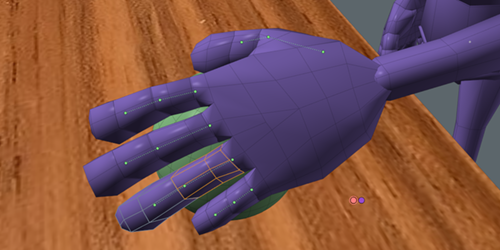
LMB+clicking the mode button opens the popup allowing users to choose the alternate modes. Once a mode other than 'None' is chosen, the additional items with implied selections are indicated in the 3D viewports by small colored dots at each items 'Center' position, with the hierarchy connections visible as dotted lines drawn between the items. In this illustration (above) the 'Branch Related' mode is selected so the single finger joint that is explicitly selected also implicitly selects all the other fingers. The colors for each represent their keyframe status, same as the general controls, where Green is animated, Red is a keyframe position, Blue is a mixed state and Orange for non-animated elements.
![]() Pose Tool
Pose Tool
The Pose Tool allows users to easily pose and animate hierarchies of elements using a simplified drag and pin workflow. When the Pose Tool is active it simulates an IK type of setup between elements. IK or Inverse Kinematics is the ability to animate the position of a goal item and have other related elements automatically follow, reaching toward the goal as it moves. This helps to simplify the animation workflow greatly, making for an intuitive method to position elements. Though often used with bipedal characters, the Pose Tool is not specifically limited to only working with these types of setups. Any type of hierarchy of joints, items or otherwise can be manipulated with the Pose Tool, and it is equally effective in all these situations.
The basic workflow is to select the base, or root element of a hierarchy, and then LMB+click the Pose tool button to activate. When active, blue dots draw on each items Center in the 3D viewport for all elements within the selected hierarchy. From there users can LMB+click and drag on any dot to move the target element, also affecting the related elements in the chain. How far the related elements move is dependent on how far the target itself is dragged, their position relative to the target and the 'Weighting' value defined in the Pose Tools properties panel. When this isn't the desirable behavior, specific items can also be pinned in order to keep them from moving. Users can apply this by RMB+clicking directly on any dot, changing its color to red, indicating its locked state. Further position changes on either side of the locked element will keep the elements on the opposing side stationary.
While seemingly basic, the Pose Tool offers a simple to use, but powerful means of working with characters. For more detailed information on the Pose Tool, please reference that page of the documentation.
The Channel Haul tool allows users to adjust any items selected Channels by dragging with the mouse directly in the 3D viewport.

The visible channels available within the viewport display are dependent on the channels that are directly selected in either the 'Properties' or 'Channels' viewport. LMB+clicking on the 'Channel Haul' tool button or use the 'C' keyboard shortcut activates the tool and the viewport display in the 3D viewport. LMB+clicking and dragging anywhere off the display will simultaneously edit all active fields. This can be limited to specific channels by toggling the boolean buttons preceding each channel. The top-most boolean toggle will enable or disable all channels at the same time. Editing values individually is done by clicking on the channel name in the display and dragging the mouse, interactively adjusting the value. Users can also numerically enter a new value by clicking the value itself and entering a new one. The channel haul tool can modify up to 6 chosen channels.
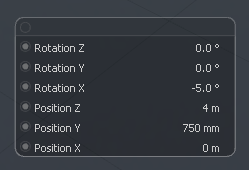
When no channel is selected, the display reflects this reminder that the tool is still active. Click the 'Channel Haul' button again to disable or press the 'q' key to drop the tool.

![]()
![]() Apply/Discard Changes Buttons
Apply/Discard Changes Buttons
The 'Apply' and 'Discard' buttons allow changes users have made to Channels to be applied to the 'Scene'/'Action' or discarded en-mass. This is very useful when one wants to commit any changes without having to scrub the timeline and return to the frame that was previously being editing, or to erase all changes quickly. The latter is a quick way to return anything thats been edited back to it's previous values without having to undo multiple times or to go through all the changed channels and reset them manually. An example would be adjusting a pose or testing rigging controls, these buttons allow users to make many adjustments to many items and then either 'Apply' them if you're happy with the changes or 'Discard' them if you're not with a single button click.

This section of the Animation interface layout works like a spreadsheet, presenting all the transform values for the current selection. Each row is dedicated to its specific transform, either Position, Rotation or Scale, top to bottom respectively. Each column has a like function for each row. The first column on the left has the tool toggles that enable/disable the actual transform tool associated with it, the second column will automatically set a keyframe for all three axes of the specific transform. The 'X', 'Y' and 'Z' input fields represent the current values for the item, working the same way as any input field. The last column on the right, the buttons with the circles will 'Reset' the item, adding a keyframe for all three values of the given transform to '0' (zero).
The animation layout directly supports three different types of 'Action Centers' that automatically orient the transform tools handles when working with items. 'World Coordinates' (left icon pictured above) when enabled will orient the handles to the world based XYZ planes in the scene. The 'Local' option (right icon), when enabled, will orient the handles match the orientation of the target element that is being modified (local as in local to the selected item). When both are disabled, the default state, then the orientations of the tool handles will match the 'Parent' item of the selected element, allowing users to transform items relative to the item that defines its orientation. LMB+clicking the buttons in the interface will toggle the modes on or off.
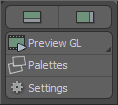
The last bank of button in the animation layout are convenience toggles that hide and unhide viewports in the animation layout, provide an option to convert the GL viewports to video/frames and provides direct access to a variety of important utility viewports in the form of palettes. The top left button toggles the visibility of the Graph Editor/Dope Sheet viewport. When the button is LMB+clicked the viewport will open below the 3D viewport, LMB+clicking it again will hide the viewport. The top right button toggles visibility of the familiar Item list/Properties panel viewport cluster of tabs present in the other interfaces. Depending on the amount of screen real-estate available, being able to toggle these views makes an easy way to maximize the main 3D viewport workspace when its necessary to focus on the animation itself.
The 'Preview GL' options offers users a way to convert the GL viewport into a video or frame sequence format for external playback. This can be useful for a variety of reasons. In complex scenes it can reduce any hardware limitations, allowing for full speed, full frame playback. It can also be useful for reviews, allowing users who don't own MODO to see an animations for approval purposes. No matter what it is used for, it is really essential and MODO makes video previews easy to create. When any of the commands are selected, any visible HUD elements, including the navigation icons, information overlays, tool feedback overlays and onion skinning are temporarily disabled to keep the resulting video uncluttered. Only the frame number will be displayed. When recording has completed, the HUD elements will be restored to their previous state.
MODO provides three basic options. The 'Preview' options provide a one-click way to make a temporary video that opens in an external player for review. The video format is determined by the settings of the "Movie I/O" preference setting. The size is determined by the actual size of the active 3D viewport when the command is invoked. Once MODO has created the video file itself, it calls the OS for the default playback mechanism for the chosen format, so make sure you have proper video playback support in your OS before creating a preview. LMB+clicking the button invokes the command, where MODO will sequentially go through each frame step of the Current Start and End times and create the Preview file. Once it is created, the default playback application will open with the video automatically loaded. Users can then use the controls of the playback software to view the video.
RMB+clicking on the Preview GL button opens the Preview menu where users can select the alternate options. 'Preview GL 1/2' will produce a video at half the size of the 3D viewport and 'Preview GL 1/4" will produce a video that is one quarter the size of the 3D viewport. The 'Record GL' options provide identical video files, with the same 1/2 and 1/4 options, however invoking these commands will prompt the users to define a 'Save' location and Filename. So 'Preview GL' should be used For quick local reviews and 'Record GL' when files will need to reviewed at a later time or sent to another location.
The last option 'Image Sequence' will save an sequence of bitmap images that match the active viewport size to the designated Folder. Invoking the command will open an OS specific folder allowing the users to define the location and provide a filename and format for the preview. Once specified, MODO will sequentially step through the timeline saving a file for each frame. A sequence player or video editing application will be necessary to gather the still frames into a playable video sequence.
![]() Palettes
Palettes
The 'Palettes' button opens a menu that allows users to choose from a variety of useful viewports that will open as floating palettes in the Animation workspace. This eliminates the need to switch to an alternate workspace Layout for simple tasks. The buttons act as toggles, LMB+clicking will open named palette on the first click, and the second click will close the palette. Opened palettes can be arranged by LMB+clicking and dragging the header on the palette, where they can also be closed by clicking the OS specific close icon. While the palettes are open, their visibility can be temporarily toggled by pressing the grave accent (`) key (this is also the tilde (~) key next to the 1 on American keyboards).
![]() Settings
Settings
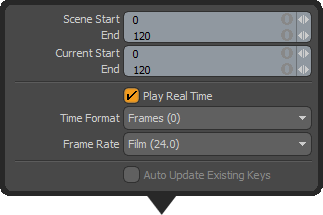
The 'Settings' button opens the scene options panel allowing users to define frame ranges for animations and set some formats and default behaviors.
Scene Start/End: Sets the sequence length using the Start and End frame numbers.
Current Start/End: Sets the current length using the Start and End frame. When animating, users may wish to concentrate on a single area of a scene for fine tuning, the current range setting allows the users to essentially temporarily crop out the rest of the scene so they can concentrate on the one section. LMB+double click on the timeline to reset the 'Current' range to the 'Scene' range.
Play Real Time: When enabled the sequence will play back an OpenGL viewport using the 'Frame Rate' setting to the best of the host systems abilities, skipping frames if necessary. When disabled MODO will play every frame in the sequence at the fastest speed possible, which depending on scene complexity may be slower or faster than the specified frame rate.
Time Format: Allows the user to specify which standard is used when displaying individual frame numbers
Frames- Indicates frames as sequential numbers, using standard numbering format.
Seconds- Indicates frames as a passage of time, using the "0.0s" format.
SMPTE- SMPTE time code specifies frames utilizing a shorthand method "00:00:00:00"; representing hours:minutes:seconds:frames
Film Code- Specifies frames by the length of the film in feet (linear measurement) using "0.0 + 0" format.
Frame Rate: Users can specify a frame rate by standard definitions, such as Film (24 fps), PAL (25 FPS), and NTSC (29.97 fps). Frames Per Second, usually referred to as FPS, is the number of still images that playback in sequence in one second of time.
Auto Update Existing Keys: This option is only available when 'Auto Key' is 'Off'. Normally when Auto Key is off any edits that are made will be discarded when the current time is changed unless they have been manually keyed. This option allows existing keyframes to be updated automatically if their values are changed without requiring manual keying, un-keyed changes will still be discarded when the current time is changed.


